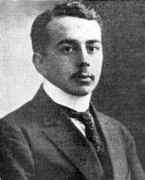Person: König (3), Dénes

Dénes König was a Hungarian mathematician who worked in graph theory.
Mathematical Profile (Excerpt):
- Dénes received an excellent education in Budapest, attending one of the best schools, a Gymnasium, in the city.
- Dénes König had a most remarkable high school career for he achieved things that are basically unheard of for a school pupil.
- He also pointed out that König included not only elementary problems but also included more advanced material.
- Both Beke and Szijártó were strong advocates of reforming mathematical education and this book by König was clearly seen as part of that project.
- Later in 1902, König entered the University of Budapest where he spent four semesters.
- Kürschák's works are cited in two places in König's books on mathematical recreations published in 1902 and 1905.
- Over the following years when he worked as a docent, König gave courses on Analysis Situs, Nomography, Real Numbers, Set Theory, Real Numbers and Functions, and Graph Theory.
- From 1913-14 until 1927, in addition to teaching mathematics students, König also taught mathematics to students of Architecture and Chemical Engineering.
- In the years 1918 and 1920 König published important books.
- Several Hungarian mathematicians learned the topology of surfaces from König's book.
- Out of consideration for the beginner, König uses an intuitive approach.
- These lectures contributed to König's growing interest in graph theory, but there were other reasons for his interest in the topic.
- König saw that the use of graph theory had greatly helped visualise problems and help to solve them.
- In 1914 he attended the Congrès de philosophie mathématique in Paris where he gave a lecture in which he presented a graph theory result known today as the 'Theorem of König'.
- However, he published the 'Theorem of König' in a Hungarian paper of 1916 and also in a German paper Über Graphen und ihre Anwendung auf Determinantentheorie und Mengenlehre Ⓣ(On graphs and their application to the theory of determinants and set theory) in the same year.
- König's use of graphs to give a simpler proof of a determinant result of Georg Frobenius seems to have led to some hostility between the two men.
- Frobenius's reducible determinant theorem was published in 1912 while König's simpler proof, in terms of the perfect matchings of a certain bipartite graph, appeared in 1915 in his paper Line systems and determinants (Hungarian).
- It was not only Gyula König who was interested in set theory, however, for Dénes König also made some important contributions to the topic.
- Forms of this lemma appear in König's papers of 1926 and one of 1927, namely Über eine Schlussweise aus dem Endlichen ins Unendliche Ⓣ(On an inference from the finite to infinity) which is entirely devoted to the infinity lemma.
- to König's great credit, he had been able to isolate the lemma and to understand its wide applicability.
- König's book, Theorie der endlichen und unendlichen Graphen Ⓣ(Theory of finite and infinite graphs), was published in 1936, and was a major factor in the growth of interest in graph theory worldwide.
- It was reprinted by Chelsea in 1950 and even though many texts on the subject have appeared since then, König's book remains one which is still frequently cited.
- As well as the translation, the English edition contains a 43-page Commentary by W S Tutte and a Biographical sketch of König by Tibor Gallai.
- In the former, Tutte summarises, chapter by chapter, the material treated by König and also discusses later developments, so providing an historical perspective on König's work.
- In the Preface to his 1936 book, König discusses whether graph theory is a branch of topology or a branch of combinatorics.
- A friend of my parents, a statistician, once said about Dénes König: "He is great in his art but his art is so small".
- Sadly König did not live to see this explosion of interest in graph theory which, at least in part, was motivated by his contributions.
- König, however, although Jewish, was brought up a Christian and so was not in danger from this particular persecution of Hungarian Jews.
- König worked to help persecuted mathematicians.
- This government moved immediately against all Hungarian Jews, and suddenly König's protection through his Christianity vanished overnight.
- A reign of terror was launched against the Jews of Budapest and, rather than suffer the horrors that faced him, König took his own life.
Born 21 September 1884, Budapest, Hungary. Died 19 October 1944, Budapest, Hungary.
View full biography at MacTutor
Tags relevant for this person:
Origin Hungary, Topology
Thank you to the contributors under CC BY-SA 4.0! 

- Github:
-

- non-Github:
- @J-J-O'Connor
- @E-F-Robertson
References
Adapted from other CC BY-SA 4.0 Sources:
- O’Connor, John J; Robertson, Edmund F: MacTutor History of Mathematics Archive
